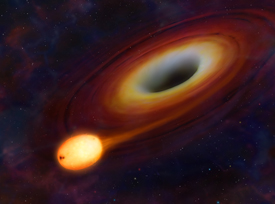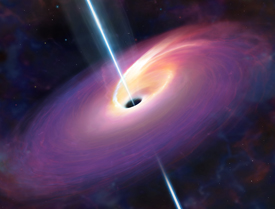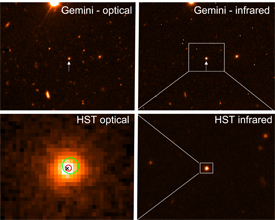Extreme gamma radiation from black hole in a distant galaxy
An extremely powerful burst of gamma radiation has been observed in a distant galaxy. Usually gamma-ray bursts are seen as one burst from an exploding giant star. This new observation is a series of bursts of gamma radiation coming from the centre of a distant galaxy. The gamma radiation is most likely due to a star that has been swallowed up by a super massive black hole at the centre of the galaxy. The gamma radiation was observed with the Swift satellite by an international team of researchers including members from DARK and the results have been published in Science Express.

Artist's impression showing the first stages of the infall of the star into a supermassive black hole. Gravitational pull distorts the shape of the star until its finally torn apart.
Gamma-ray-bursts are among the most extreme physical processes in the universe. When large, massive stars that are more than ten times as massive as the Sun die, there is an enormous supernova explosion, which in rare instances is accompanied by a powerful explosion of gamma radiation, called gamma-ray bursts, which typically last a few minutes. The new observation is not just one, but an entire series of gamma-ray bursts spread over several weeks.
Star blasted to bits
"We have localized the gamma radiation as coming from the centre of a small star-forming galaxy approximately 3.8 billion light years from the Earth”, explains Antonio de Ugarte Postigo, an astrophysicist at the Dark Cosmology Centre at the Niels Bohr Institute at the University of Copenhagen.

Artist's impression showing how the debris of the gravitationally disrupted star swirls towards the central black hole. In the process, intense electromagnetic emission is released through highly collimated jets.
He explains that the it is most likely a case in which a star has come too close to the galaxy’s black hole, which then pulled at the star so that it was torn to pieces and blasted to bits and every time a clump of the star fell in towards the black hole it created a violent, energetic burst of gamma radiation and X-ray radiation. When the eruption was at its peak, the light intensity was around 100 times greater than the brightest centres of active galaxy nuclei.
The burst was first observed using the Swift Satellite and was later observed from Earth using the Nordic Optical Telescope, NOT, on the Canary Island, La Palma, among others.
 Optical (left) and infrared (right) images of Sw 1644+57 obtained from ground based (top) and from the Hubble Space Telescope (bottom). The infrared light is being emitted mostly by the stellar disruption at the nucleus of the galaxy, whereas the optical light is dominated by the emission of the galaxy itself.
Optical (left) and infrared (right) images of Sw 1644+57 obtained from ground based (top) and from the Hubble Space Telescope (bottom). The infrared light is being emitted mostly by the stellar disruption at the nucleus of the galaxy, whereas the optical light is dominated by the emission of the galaxy itself."With the Nordic Optical Telescope we could identify where the burst originated from and we observed the light through different filters and in that way could describe its spectrum, i.e. light intensity as a function of wavelength. We could establish that the properties of the radiation were quite different than any other burst observed. The light itself was very broad spectrum and ranged from radio waves to infrared- and visible light to X-ray waves”, explains astrophysicist Giorgos Leloudas, Dark Cosmology Centre at the Niels Bohr Institute, University of Copenhagen and says that similar bursts have never been observed.
Rare occurrence
Because the burst is associated with the centre of the galaxy astronomers believe that it means the phenomenon is a rare mechanism connected to a supermassive black hole in the nucleus of a galaxy. And even though it is an extremely powerful event, the only reason we can observe it here on Earth is that our solar system happens to be located right in the direction where the energy beam was shot out into space.
Astronomers explain reassuringly that this type of event is so rare that even though it could happen in all galaxies – including our galaxy, the Milky Way, it will only happen a few times during a galaxy’s lifetime and the Sun is nowhere near the centre of the Milky Way, so we are safe.
Article in Science Express >>
